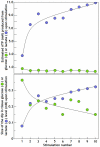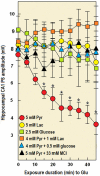Aerobic production and utilization of lactate satisfy increased energy demands upon neuronal activation in hippocampal slices and provide neuroprotection against oxidative stress
- PMID: 22275901
- PMCID: PMC3257848
- DOI: 10.3389/fphar.2011.00096
Aerobic production and utilization of lactate satisfy increased energy demands upon neuronal activation in hippocampal slices and provide neuroprotection against oxidative stress
Abstract
Ever since it was shown for the first time that lactate can support neuronal function in vitro as a sole oxidative energy substrate, investigators in the field of neuroenergetics have been debating the role, if any, of this glycolytic product in cerebral energy metabolism. Our experiments employed the rat hippocampal slice preparation with electrophysiological and biochemical methodologies. The data generated by these experiments (a) support the hypothesis that lactate, not pyruvate, is the end-product of cerebral aerobic glycolysis; (b) indicate that lactate plays a major and crucial role in affording neural tissue to respond adequately to glutamate excitation and to recover unscathed post-excitation; (c) suggest that neural tissue activation is accompanied by aerobic lactate and NADH production, the latter being produced when the former is converted to pyruvate by mitochondrial lactate dehydrogenase (mLDH); (d) imply that NADH can be utilized as an endogenous scavenger of reactive oxygen species (ROS) to provide neuroprotection against ROS-induced neuronal damage.
Keywords: LDH; NADH; glycolysis; hippocampal slice; lactate; neuronal function; neuroprotection; reactive oxygen species.
Figures











Similar articles
-
Lactate, not pyruvate, is neuronal aerobic glycolysis end product: an in vitro electrophysiological study.Neuroscience. 2007 Jul 13;147(3):613-9. doi: 10.1016/j.neuroscience.2007.05.002. Epub 2007 Jun 8. Neuroscience. 2007. PMID: 17560727
-
Glycolysis Paradigm Shift Dictates a Reevaluation of Glucose and Oxygen Metabolic Rates of Activated Neural Tissue.Front Neurosci. 2018 Oct 10;12:700. doi: 10.3389/fnins.2018.00700. eCollection 2018. Front Neurosci. 2018. PMID: 30364172 Free PMC article.
-
An increase in lactate output by brain tissue serves to meet the energy needs of glutamate-activated neurons.J Neurosci. 1999 Jan 1;19(1):34-9. doi: 10.1523/JNEUROSCI.19-01-00034.1999. J Neurosci. 1999. PMID: 9870935 Free PMC article.
-
Cerebral glycolysis: a century of persistent misunderstanding and misconception.Front Neurosci. 2014 Nov 19;8:360. doi: 10.3389/fnins.2014.00360. eCollection 2014. Front Neurosci. 2014. PMID: 25477776 Free PMC article. Review.
-
Lactate: the ultimate cerebral oxidative energy substrate?J Cereb Blood Flow Metab. 2006 Jan;26(1):142-52. doi: 10.1038/sj.jcbfm.9600174. J Cereb Blood Flow Metab. 2006. PMID: 15973352 Review.
Cited by
-
Timed consumption of a New Zealand blackcurrant juice support positive affective responses during a self-motivated moderate walking exercise in healthy sedentary adults.J Int Soc Sports Nutr. 2019 Aug 2;16(1):33. doi: 10.1186/s12970-019-0300-0. J Int Soc Sports Nutr. 2019. PMID: 31375128 Free PMC article. Clinical Trial.
-
Lactate shuttling and lactate use as fuel after traumatic brain injury: metabolic considerations.J Cereb Blood Flow Metab. 2014 Nov;34(11):1736-48. doi: 10.1038/jcbfm.2014.153. Epub 2014 Sep 10. J Cereb Blood Flow Metab. 2014. PMID: 25204393 Free PMC article. Review.
-
Lactate Provides Metabolic Substrate Support and Attenuates Ischemic Brain Injury in Mice, Revealed by 1H-13C Nuclear Magnetic Resonance Metabolic Technique.Biomedicines. 2025 Mar 24;13(4):789. doi: 10.3390/biomedicines13040789. Biomedicines. 2025. PMID: 40299353 Free PMC article.
-
Tracing the lactate shuttle to the mitochondrial reticulum.Exp Mol Med. 2022 Sep;54(9):1332-1347. doi: 10.1038/s12276-022-00802-3. Epub 2022 Sep 8. Exp Mol Med. 2022. PMID: 36075947 Free PMC article. Review.
-
Cerebral metabolism following traumatic brain injury: new discoveries with implications for treatment.Front Neurosci. 2015 Feb 9;8:408. doi: 10.3389/fnins.2014.00408. eCollection 2014. Front Neurosci. 2015. PMID: 25709562 Free PMC article. Review.
References
-
- Atlante A., de Bari L., Bobba A., Marra E., Passarella S. (2007). Transport and metabolism of l-lactate occur in mitochondria from cerebellar granule cells and are modified in cells undergoing low potassium dependent apoptosis. Biochim. Biophys. Acta 1767, 1285–129910.1016/j.bbabio.2007.08.003 - DOI - PubMed
LinkOut - more resources
Full Text Sources

